Getting Started
Lettuces are easy to grow, and come in many colours, flavours and textures – your salads need never be boring! Choose from large, hearting lettuces to loose-leaf types and salad-leaf mixes for growing in even the smallest spaces.

Lettuces (Lactucasativa)are among the most popular crops to grow – quick, easy and delicious, they’re compact enough for even the smallest garden, balcony or patio container. A single packet of seeds can give you pickings all summer if sown little and often. With their lush and often decorative leaves, lettuces are pretty enough to plant in flower borders and container displays, or as an attractive edible edging to veg beds.
Lettuces are best sown regularly in small batches to provide continuous harvests and avoid gluts. This is particularly true with hearting lettuces, which should be cut as soon as they mature, before they flower ( ), so you only need a few ready at the same time. Loose-leaf lettuces and salad-leaf mixes are even more simple and speedy to grow than hearting types and are harvested as a cut-and-come-again crop over several weeks.
Although lettuces are easy to grow, they usually need protection from slugs and snails. Hot, dry weather can triggerpremature flowering, which turns the leaves bitter, so keep them well-watered and lightly shaded in summer, and re-sow regularly so you always have replacements on hand.
Home-grown lettuces beat shop-bought versions hands down for freshness, flavour and choice. So why keep forking out for plastic-wrapped lettuces that all too often end up wilting in the fridge? It makes much more sense to grow them yourself, to enjoy whenever you want them, at their tastiest, nutritious best.
Month by Month
Sow
Plant Out
Harvest
Choosing What To Grow
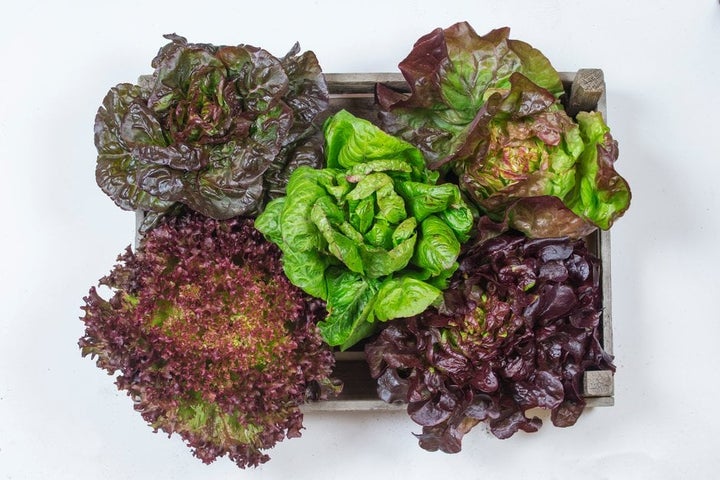
There is a huge array of lettuce varieties to choose from – ranging from crisp and crunchy to succulent and juicy, vibrant green to deep red, frilly, wrinkled or smooth, and much more. One of the joys of growing your own is the wide diversity of leaves, far greater than you can buy in supermarkets. There are hearting types, fast-growing loose-leaf varieties and lots of different salad mixes too.
Hearting lettuces
With their dense centre, these lettuces generally take up to three months to reach harvesting size and you then cut the whole head. These are best grown in the ground, as they take up more space, but can also work in large containers. There are three main types:
- Butterhead lettuces have an open shape and soft juicy leaves with a mild flavour. They are fairly quick to mature and tolerate poorer growing conditions. Eat them fresh as they don’t store well
- Cos lettuces (also known as romaine lettuces) have an upright, oblong head and the leaves have a crisp mid-rib. They come in various sizes, including compact ‘Little Gem’, which is ideal when space is tight or when you only want small servings
- Crisphead lettuces produce large hearts of curled, crisp leaves with a mild flavour. They are more resistant to bolting (flowering prematurely) and store well in the fridge. This type includes the popular iceberg lettuces
Loose-leaf lettuces and salad-leaf mixes
These produce less dense of foliage, ideal for picking individual leaves and for growing in small spaces and containers. They can be highly decorative, both in the garden and on the plate, with a range of leaf colours, shapes, textures and flavours. These are quicker to grow than hearting types and you can often pick your first leaves only about a month after sowing, and continue for several weeks on a cut-and-come-again basis.
More inspiration
For easy, reliable and tasty varieties, look for those with an RHS Award of Garden Merit (AGM), which shows they performed well in trials – see ourlist of AGM fruit and veg (135kB pdf) and our Recommended Varieties below. Also, for more veg-growing inspiration, visit the RHS gardens, which all grow a range of lettuces and salad crops.
What and where to buy
Most gardening retailers sell a wide choice of lettuce seeds – you can buy a single variety or a mix of varieties offering different flavours and leaf colours. Although lettuce seeds are cheap, they don’t generally store well, so it’s best to buy fresh seeds each year, for more reliable . Packs of are also available from most garden centres and online gardening retailers through spring and early summer, although the choice of varieties is more limited.
Recommended Varieties

'Winter Density' AGM
Cos – produces low, crisp hearts. Good winter hardiness and bolt resistance.

'Hollywood' AGM
Crisphead – medium-sized iceberg variety. Dense, round head with few wasted outer leaves.

Preparing The Ground
Choose a growing site with fertile, moisture-retentive soil. A sunny spot is usually best, but if sowing/planting in the middle of summer, some light shade is preferable during the hottest part of the day, as too much heat can cause lettuces to flower prematurely.
Weed the ground thoroughly and remove any large stones, then dig in plenty of garden compost, to help retain moisture. Alternatively, if you're practising no-dig, the ground ahead of sowing or planting directly into the mulch.
Sowing
Lettuce seeds can be sown indoors or outdoors, in containers or in the ground, from spring through to autumn. Lettuce plants, especially loose-leaf varieties, take up very little space, so are handy for filling any small gaps on the veg plot. They can also be sown between slower-growing crops, such as parsnipsandsweetcorn, as they will be harvested before the main crop needs the space.
When to sow
This depends on when you want to harvest:
- For summer and autumn harvests: sow outdoors from late March to late July. For an even earlier crop, sow indoors in early February and plant out in early March undercloches
- For early winter harvests: sow outdoors in early August and cover plants with cloches from late September onwards. Alternatively, grow in a greenhouse border or container
- For spring harvests: sow a winter variety such as ‘Winter Density’ in September/October, either in a greenhouse or in mild areas under cloches or in a coldframe
When sowing in summer, bear in mind that high temperatures can prevent some varieties from . So during hot spells, sow in the evening, water with cold water and provide some shade to keep temperatures down.
Sowing indoors
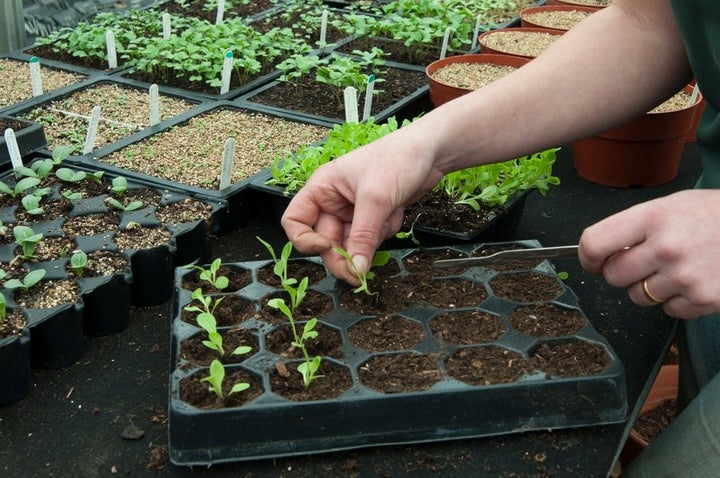
Sow lettuce seeds thinly in small pots, seedtrays or modular trays filled with moist, peat-free , then keep in a warm, bright location such as on a windowsill or in a . Sowing indoors gives plants a head start when conditions outside are still too cold, and keeps the safe from slugs and snails until they’re larger and more resilient. For more sowing tips, see our guides below.
Carefully move seedlings into individual /pots once they have a few leaves and are robust enough to handle – see our video guide to pricking out, below. Then plant them outside from spring onwards, once they’re growing strongly (see the Planting section below). During the colder months, they are best kept under cover, planted in a greenhouse border or large container.
Sowing outdoors
Sow lettuce seeds thinly into prepared soil (see above), 1cm (½in) deep, in rows 30cm (1ft) apart. Sow a short row every fortnight to provide non-stop harvests and avoid gluts.
Thin out lettuce gradually to 15–30cm (6–12in) apart – check the seed packet for exact spacings. is particularly important with hearting lettuces, as they may not form a firm head if overcrowded. The seedlings you remove can be added to salads.
Protect lettuce seedlings and young plants from slugs and snails. In early spring, you may also need to protect them from birds and cold temperatures by covering with cloches or plastic-free fleece.
Sowing in containers
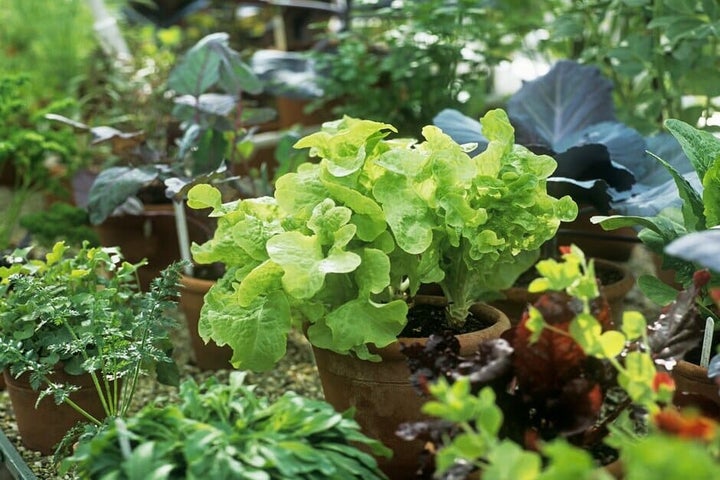
You can sow lettuces in large containers (at least 30cm/1ft wide) filled with moist, peat-free multi-purpose . Growing bags are also suitable. They can then be kept outdoors or in a coldframe or greenhouse. Thin out the seedlings to the spacings given above. For more container-growing tips, see our easy sowing guides below.
Planting
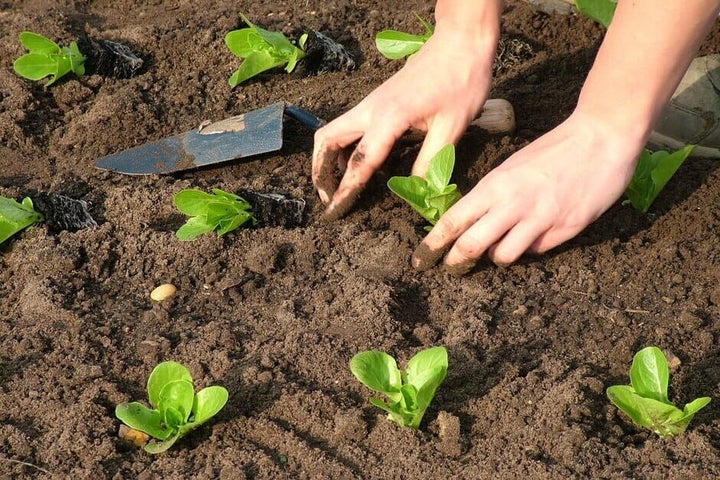
Young lettuce plants grown from seed indoors, or bought as plug plants, can be moved outside from spring onwards. Prepare the plants for outdoor conditions by hardening off before planting. Choose a warm, sunny planting site, prepared as above, or plant into a large container, at least 30cm (1ft) wide and deep, filled with peat-free multi-purpose , then place in a warm, sunny spot.
Space larger hearting lettuces about 30cm (1ft) apart – if planted too closely, they won’t form good hearts. Plant smaller loose-leaf types about 15cm (6in) apart. In spring and in colder regions, plants will establish more quickly if covered with cloches or plastic-free fleece.
In hot weather, young transplants can quickly wilt, so water regularly and choose a lightly shaded spot, which should also deter . Protect lettuces from slugs and snails, especially in damp weather. Early in the year, birds can be a problem too, as they find young lettuces irresistible. Protect with plastic-free , chicken wire or similar.
Winter harvests
Hardy lettuce varieties provide harvests over winter and into early spring. Plant in late summer or early autumn in a greenhouse border, or in large containers to keep in a greenhouse or coldframe. In warm locations you could plant outdoors under cloches.
Plant Care
Watering
Water young and newly lettuces regularly in warm, dry weather. Aim to keep the soil consistently moist, as a lack of water can cause bolting, which ruins the crop. Plants in containers are particularly vulnerable, as the can dry out rapidly, so keep them out of the midday sun and check them regularly – they may need watering daily in summer.
The best time to water is early in the morning, to set the plants up well for the day. Try to avoid watering in the evening, as the dampness can attract slugs and snails overnight, as well as encourage fungal diseases such as grey mould. For more water-wise tips, see our guides below.
Mulching
Apply a thick layer of , such as garden compost, around lettuce plants once they are growing well, to help hold moisture in the soil and stop it drying out in hot weather.
Feeding
Lettuces don’t usually need feeding, but if you grow them in a container, you can apply a general-purpose organic liquid feed fortnightly through the summer.
Weeding
Keep and young lettuce plants free of weeds, so they don’t have to compete for water or sunlight, which can slow their growth. Dense weeds can also offer hiding places for slugs and snails, and reduce air circulation, which can encourage fungal diseases such as grey mould.
Bolting
When lettuces flower, the leaves turn bitter and inedible. They tend to start flowering (known as ) sooner in hot, dry weather, so take care to site them in light shade during the hotter months and water regularly. If bolting has been a problem before, choose varieties, including crisphead and cos types, that are more resistant. However all lettuces will eventually flower if left long enough, so don’t delay harvesting once plants have formed a good heart.
Harvesting
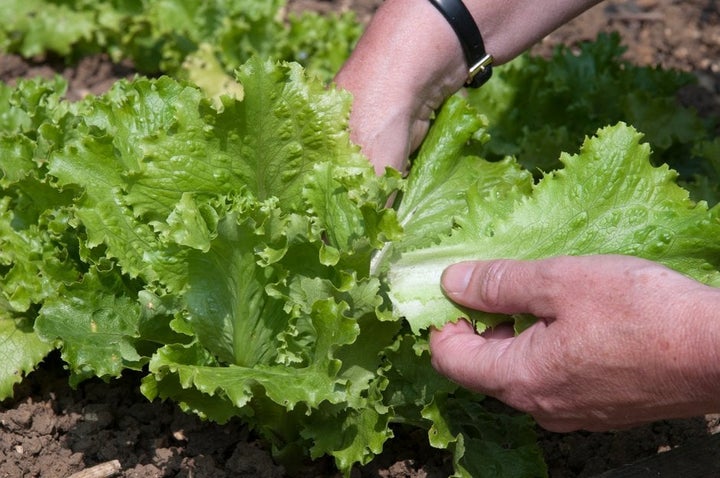
You can harvest lettuces from late spring through to winter, if sown regularly using suitable seasonal varieties. Lettuces grow fastest in warm weather, with loose-leaf varieties ready to pick in as little as four to six weeks. Hearting lettuces take longer, around 10 to 14 weeks, depending on the variety and time of year. Harvest in the morning if possible, when the leaves are fresh and juicy. In hot weather, put individual leaves straight into water to keep them from wilting.
Whole lettuces are ready to harvest when a firm heart has formed – cut through the stem leaving a stump about 2.5cm (1in) tall. This should re-sprout leaves to give you at least one, if not two, additional smaller harvests.
Loose-leaf varieties can be harvested as soon as the leaves are big enough to be worth eating, when about 10cm (4in) long. Harvest as a cut-and-come-again crop – either snip a few leaves from each plant along the row, or let plants grow to maturity and snip all the top growth in one go, leaving a short stem that should re-sprout at least one more crop of foliage, as long as the weather isn’t too hot or dry.
Problem Solving
Lettuces are attractive to various garden creatures, including slugs and snails, aphids and cutworms, while birds sometimes peck young in early spring. In cool, humid summers, grey mould may affect the leaves, and in hot, dry weather lettuces may start flowering ( ), which turns the leaves bitter. Hot weather can also reduce seed , so in summer sow on cooler days or in the evenings, once temperatures drop. For more on these and other issues, see Common problems, below.
Common Problems

Bolting in vegetables
Bolting is the term applied to vegetable crops when they prematurely run to seed, usually making them unusable. A cold spell or changes in day length...

Grey mould
Grey mould, caused by the fungus Botrytis cinerea, is a very common disease, causing a soft decay of plant tissues accompanied by a growth of fuzzy gr...













